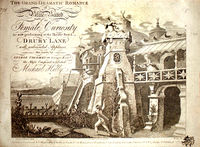Annotation:Blue Beard: Difference between revisions
Created page with "'''Back to [[{{BASEPAGENAME}}]]''' ---- <p><font face="garamond, serif" size="4"> '''BLUE BEARD.''' English, Country Dance Tune (2/4 time). A Major. Standard tuning (fiddle). ..." |
No edit summary |
||
| (6 intermediate revisions by 2 users not shown) | |||
| Line 1: | Line 1: | ||
------------ | |||
---- | {{TuneAnnotation | ||
|f_tune_annotation_title= https://tunearch.org/wiki/Annotation:Blue_Beard > | |||
'''BLUE BEARD.''' English, Country Dance Tune (2/4 time). A Major. Standard tuning (fiddle). AABB. | |f_annotation='''BLUE BEARD.''' AKA and see "[[March in Bluebeard]]." English, Country Dance Tune (2/4 time). A Major. Standard tuning (fiddle). AABB. '''Blue Beard; or Female Curiosity''' was a pantomime produced in 1798, with music by Michael Kelly and text by George Colman, the Younger. Advertised as a "Grand Dramatick Romance" it was written as an alternative for a Christmas pantomime, accessible to children in the audience. The Royal College of Music's Virtual Exhibition (Pantomime and the Orient) explains: | ||
[[File:bluebeard.jpg|200px|thumb|left|The 1798 publication of Blue Beard]] | |||
< | <blockquote> | ||
''Scenic spectacles and rapid transitions, brought about by Harlequin’s magic wand were the stock-in-trade of'' ''pantomime, and they brought good box-office returns. Michael Kelly had seen Grétry’s opera Barbe Bleue, based on'' ''Perrault’s fairy tale, in Paris in 1790. He paid Colman to make a libretto out of it, and Colman turned the French'' ''villain into a Turkish one, Abomelique. Reviews of Blue Beard were very mixed, but the work was popular with'' ''audiences. £2000 was spent on its preparation. Its most impressive effect was a grand cavalcade across the'' ''mountains, which used model figures and animals growing larger at each successive appearance.'' [http://www.cph.rcm.ac.uk/Virtual%20Exhibitions/Music%20in%20English%20Theatre/Pages/Caption4.htm] | |||
</blockquote> | |||
'' | The tune is a version of a march from the opera, better-known under the title "[[March in Bluebeard]]." | ||
|f_source_for_notated_version= | |||
|f_printed_sources=T. Skillern ('''Twenty-Four Country Dances for the Year 1799'''), 1799; p. 11. | |||
|f_recorded_sources= | |||
|f_see_also_listing= | |||
}} | |||
------------- | |||
---- | |||
Latest revision as of 04:04, 18 February 2022
X:1 T:Blue Beard M:2/4 L:1/8 R:Country Dance B:T. Skillern - Twenty-Four New Country Dances for the Year 1799 (p. 11) Z:AK/Fiddler's Companion K:A e/f/e/d/ c/d/c/B/|AA/c/ BB/d/|cc/e/ f/e/d/c/|c/B/B/B/ B2| e/f/e/d/ c/d/c/B/|AA/c/ BB/d/|c/B/c/d/ c/B/A/G/|AA A2:| |:B>AGA|BA/B/ cB/c/|d/c/d/e/ f/e/d/c/|c/B/B/B/ B2| B>AGA|B/A/B/c/ Bc|B/^d/f/a/ g/e/f/d/|eeez!D.C.!:|]
BLUE BEARD. AKA and see "March in Bluebeard." English, Country Dance Tune (2/4 time). A Major. Standard tuning (fiddle). AABB. Blue Beard; or Female Curiosity was a pantomime produced in 1798, with music by Michael Kelly and text by George Colman, the Younger. Advertised as a "Grand Dramatick Romance" it was written as an alternative for a Christmas pantomime, accessible to children in the audience. The Royal College of Music's Virtual Exhibition (Pantomime and the Orient) explains:

Scenic spectacles and rapid transitions, brought about by Harlequin’s magic wand were the stock-in-trade of pantomime, and they brought good box-office returns. Michael Kelly had seen Grétry’s opera Barbe Bleue, based on Perrault’s fairy tale, in Paris in 1790. He paid Colman to make a libretto out of it, and Colman turned the French villain into a Turkish one, Abomelique. Reviews of Blue Beard were very mixed, but the work was popular with audiences. £2000 was spent on its preparation. Its most impressive effect was a grand cavalcade across the mountains, which used model figures and animals growing larger at each successive appearance. [1]
The tune is a version of a march from the opera, better-known under the title "March in Bluebeard."

